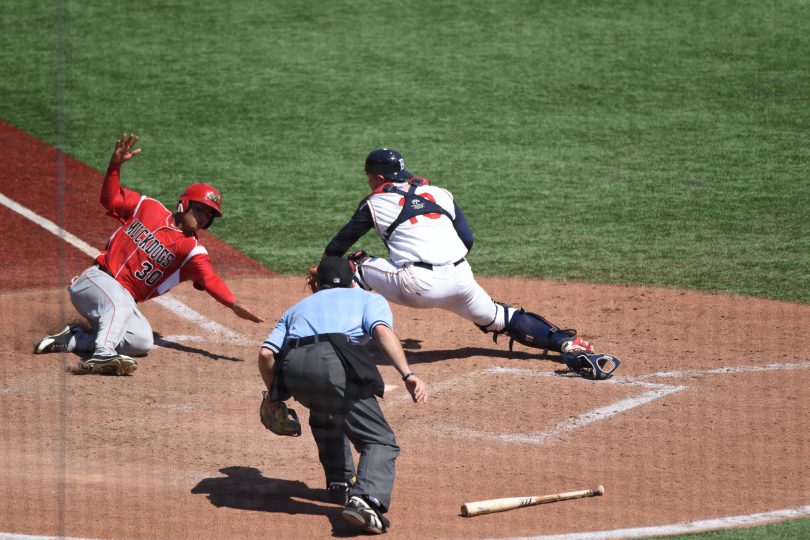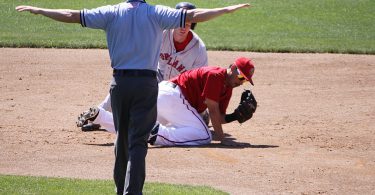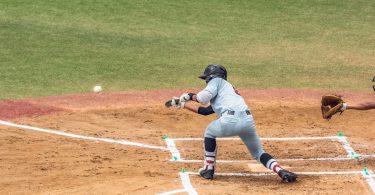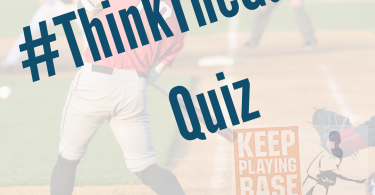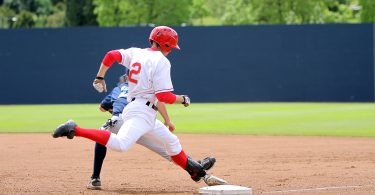The Situation:
There are runners at the corners with 1 out and a full count. The offense is down 2-0 in the top of the second inning.
The Play:
The runner at 1st takes off with the pitch, hoping to avoid the double play. The tactic works, as the left-handed batter is out front on an off-speed pitch and bounces it to the 1st baseman. He has no shot at the double play with the runner in motion, so he fields the ball ready to make the throw to home. He sees that the runner isn’t going, so he secures the ball in his glove, turns around and jogs 4 steps to tag first. As soon as he has turned his back, the base runner at third, who froze but didn’t retreat when the first baseman came up looking to throw how, takes off for home.
The Outcome:
The runner gets a great jump and catches the first baseman off guard. He tries to speed up and make the throw home. The throw is right on the money, but the head first slide is even better. The runner at third swipes the corner of home plate before the tag comes down on his wrist. He has manufactured a run.
What Went Wrong:
This play is like a chess match, with lots of quick decisions to be made by all the players involved. The runner in motion at first changes the complexion of the play by removing the double play option. This means that while the pitch is being delivered, the first baseman must change his plan from turning the routine double play to making sure the runner at third doesn’t score. The runner at third also must realize that he is no longer running on a ground ball, because the double play is no longer a threat to end the inning and you don’t want to trade a runner at 3rd for a runner at 1st with an easy out. Initially, the first baseman does a great job of thinking the game as his responsibilities change. He fields the ground ball anticipating a play at the plate, knowing he will have time to reset and get the runner at 1st if the runner at 3rd holds. The runner also does a great job of understanding his changing responsibilities. Rather than give up an easy out at home, he pauses after his secondary to read the play.
The first baseman’s mistakes start after his initial heads up play. He simply doesn’t do enough to stop the runner at 3rd. He must either ensure that the runner’s momentum is going back towards third or watch him as he goes to tag first so he can make the throw home right away. Alternatively, the first baseman could have run hard to touch first, cutting down the time the runner would have had to advance. Had he done that, he would have thrown the runner out or stopped him from attempting to advance all together. The second major mistake was having the ball in his glove as he goes to touch first. The time it takes him to transfer the ball to his throwing hand may only have taken a split second, but then, the difference between the runner being out and safe at home was only a split second as well. If he isn’t watching the runner at 3rd as he goes to touch 1st, he must spring to the bag with the ball in his throwing hand and come off of 1st ready to make the next play, just like a pitcher getting over to cover first.
The first baseman’s lack of hustle only leads to a run because the runner at third is ready to capitalize on the mistake and makes a head up slide to avoid the tag. As much as this is a think the game blunder on the part of the first baseman, it’s a think the game success story on the part of the runner at 3rd. If this play happens 100 times, it’s likely that there would only be a few chances to take home. He is able to do it when that chance comes because he is ready and looking to take the extra base. Now that’s thinking the game!

